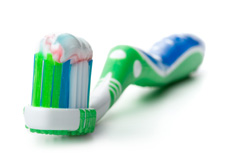 While brushing the outside surfaces of your teeth, position the brush at a 45-degree angle where your gums and teeth meet. Gently move the brush in a circular motion several times using small, gentle strokes. Use light pressure while putting the bristles between the teeth, but not so much pressure that you feel any discomfort. Brush towards the biting surface to sweep off the plaque you have dislodged with the circular motion.
While brushing the outside surfaces of your teeth, position the brush at a 45-degree angle where your gums and teeth meet. Gently move the brush in a circular motion several times using small, gentle strokes. Use light pressure while putting the bristles between the teeth, but not so much pressure that you feel any discomfort. Brush towards the biting surface to sweep off the plaque you have dislodged with the circular motion.
When you are done cleaning the outside surfaces of all your teeth, follow the same directions while cleaning the inside of the back teeth.
To clean the inside surfaces of the upper and lower front teeth, hold the brush vertically. Make several gentle back-and-forth strokes over each tooth. Don't forget to gently brush the surrounding gum tissue.
Next you will clean the biting surfaces of your teeth by using short, gentle strokes. Change the position of the brush as often as necessary to reach and clean all surfaces. Try to watch yourself in the mirror to make sure you clean each surface. After you are done, rinse vigorously to remove any plaque you might have loosened while brushing.
If you have any pain while brushing or have any questions about how to brush properly, please be sure to call the office.

Gum disease begins at the gum line and between teeth. Daily flossing is an important part of your oral health care routine to help remove the plaque from these areas where a toothbrush doesn’t completely reach. But to truly reap the benefits, you need to use proper flossing techniques.
The American Dental Hygienists’ Association explains the key elements of proper flossing technique in four simple steps:
This technique applies to any type of floss: waxed, unwaxed, spongy floss or dental tape. It doesn’t matter whether you start with your upper or lower teeth, or whether you start in the front or the back. Just make sure that you floss all your teeth, including the back side of the very last tooth on the left, right, top and bottom of your mouth. And don’t forget to floss under the gum line and along the sides of teeth that border any spaces where teeth are missing -- food particles can become trapped in these spaces, too.
There are a lot of great reasons to pick Mountain Dental and Dr. Fisher to be your dentist! In fact, there are too many reasons to list here. So, we have randomly picked four to help you see why so many patients choose to have their dental care provided by the staff at Mountain Dental.
"You are the most important person at Mountain Dental. I promise that you will be treated with the utmost respect and understanding. You will instantly recognize our commitment to exceptional staff, technology and your overall comfort."
